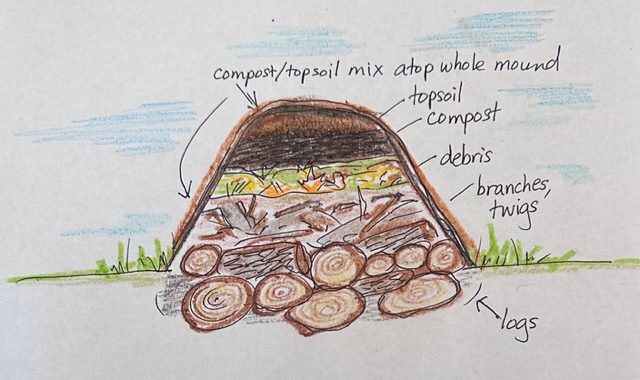Hügelkultur: What Is It?
If your gardening routine is getting a bit “flat”, then as you approach spring clean-up, consider embracing Hügelkultur, translated quite literally to “hill culture”. Hügelkultur will have you layering garden debris from your spring clean-up (most importantly, logs and branches) to arrive at mounded growing spots of nutrient-rich soil with good aeration and, eventually, good water retention. Surely, using this growing method will leave you feeling anything but flat.
I first learned of Hügelkultur when a kind arborist, a friend of the family, visited my home. In a forgotten part of the yard near a wooded area, there was a mounded strip of debris and earth and… well, to this man who was so in-the-know, it looked as though I was trying my hand at Hügelkultur.
I knew nothing of this method at the time, and I shared with embarrassment that the elongated mound the arborist was seeing was simply a waste area… a strip of forgotten plant matter that had been scraped up during spring clean-up, mixed together, with some wood rolled in.
Well, fast-forward to now, and with some good research in the years that have passed between then and now, I realize how beneficial Hügelkultur is to growing pretty much all manner of plants. Hügelkultur is a method of gardening that goes back hundreds of years in Germany, Austria, and broader Europe, where it is still used to this day.
If you have heard of “lasagna planting” for bulbs, a method in which one layer of bulbs gets layered atop another to encourage successive blooming in a single container or garden patch, then the “lasagna” concept will be helpful to keep in mind as you learn about Hügelkultur.
In Hügelkultur, layers of ready-to-go growing medium (good topsoil) and materials that can decompose over time to become rich aerated matter (wood and good garden waste, rounded up during spring clean-up) are built up. One upon the other, these layers feed off and feed into one another. The wood—sometimes massive logs, or for my size garden, small logs and larger branches—is vital to this particular “lasagna”, in that it will break down and become spongy. Nutrients slip from the wood into the soil. And because the spongy wood will hold moisture longer than will soil alone, the mound will require less watering-hose hydration than other growing areas might.
Trying Your Hand at Hügelkultur
Building a Hügelkultur mound can be a “no-dig gardening” effort. If you are trying not to till and turn your soil so as to avoid disturbing the worms and beneficial creatures working beneath its surface, then build your Hügelkultur mound atop the surface of the ground, with no digging whatsoever.
But, conversely, you could dig down just about a foot or so to create a slight depression in the earth, just perfect for holding the first layer of your “lasagna”. Whichever approach you take, the layering will look like this:
- Bottom layer: larger stumps, logs, and branches (no treated wood)
- Next layer up: smaller branches that may already be a bit spongy
- Next layer up: good garden debris, such as raked-up grass and leaves that are gathered during spring clean-up (but no chemically treated plant material)
- Next layer up: compost, which will fill a top layer and then gently cover the sloped sides of the mound
- Top layer: topsoil with a little depth at the top and then a small layer to cover the sloped sides, atop the compost

The mound that is built using these layers can be used for planting right away. Make sure there is a good amount of compost in your next-to-top layer. Then, the absolute top layer can be a bit thinner than the compost layer, with soil that can grab on to some plants and get them growing. The growth of the plants will help prevent erosion of the mound.
One thing to note is that a Hügelkultur mound can start out looking quite large, with substantial height as it is first crafted. Over time, it will shrink significantly, with the beneficial decay of the matter (the debris from spring clean-up and the wood) that is layered beneath the topsoil. But the height of the mound is not key. Instead, the nutrients, the aeration (think of the natural air pockets created by the wood and the worm action that is sure to take place), and the water retention capabilities are what make this method effective... and interesting enough to try.
So, when you do your spring clean-up this year, instead of removing every branch and twig from your yard and paying to unload it at the transfer station, consider Hügelkultur. And rather than pay a lot for a pre-assembled wood or metal raised bed, consider Hügelkultur, with its mounds that stand above the ground very naturally and without supports. This centuries-old method is a little hard on the back, but it may ultimately improve your spring clean-up routine, enliven your summer gardening, and give you an all-new method of growing healthy and beautiful plants.
Comments
{{ errors.first("comment") }}